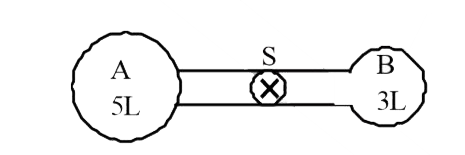A 8 litre container has gas at 14 atm. Container is connected to another empty vessel of volume 20 litres. Find the pressure exerted by the gas in the new system at constant temperature.
To solve the problem step by step, we will use Boyle's Law, which states that at constant temperature, the pressure of a gas is inversely proportional to its volume.
1. Identify Initial Conditions:
- Initial volume (V1) = 8 liters
- Initial pressure (P1) = 14 atm
2. Identify Final Conditions:
- Final volume (V2) = Volume of the first container + Volume of the second container
- V2 = 8 L + 20 L = 28 L
3. Apply Boyle's Law:
According to Boyle's Law, we have:
P1×V1=P2×V2
Where:
- P1 = Initial pressure
- V1 = Initial volume
- P2 = Final pressure (what we need to find)
- V2 = Final volume
4. Substitute the Known Values:
Substitute the known values into the equation:
14atm×8L=P2×28L
5. Calculate P2:
Rearrange the equation to solve for P2:
P2=14atm×8L28L
P2=112atm⋅L28L=4atm
6. Final Answer:
The pressure exerted by the gas in the new system at constant temperature is 4 atm.
- Initial volume (V1) = 8 liters
- Initial pressure (P1) = 14 atm
- Final volume (V2) = Volume of the first container + Volume of the second container
- V2 = 8 L + 20 L = 28 L
According to Boyle's Law, we have:
P1×V1=P2×V2
Where:
- P1 = Initial pressure
- V1 = Initial volume
- P2 = Final pressure (what we need to find)
- V2 = Final volume
Substitute the known values into the equation:
14atm×8L=P2×28L
Rearrange the equation to solve for P2:
P2=14atm×8L28L
P2=112atm⋅L28L=4atm
The pressure exerted by the gas in the new system at constant temperature is 4 atm.
Topper's Solved these Questions
- MOLE CONCEPT, STOICHIOMETRY AND BEHAVIOUR OF GASES BOOK - MTG IIT JEE FOUNDATIONCHAPTER - MOLE CONCEPT, STOICHIOMETRY AND BEHAVIOUR OF GASES EXERCISE - SOLVED EXAMPLES
13 Videos
- MOLE CONCEPT, STOICHIOMETRY AND BEHAVIOUR OF GASES BOOK - MTG IIT JEE FOUNDATIONCHAPTER - MOLE CONCEPT, STOICHIOMETRY AND BEHAVIOUR OF GASES EXERCISE - EXERCISE (MCQ)
50 Videos
- METALS AND NON METALS BOOK - MTG IIT JEE FOUNDATIONCHAPTER - METALS AND NON METALS EXERCISE - Olympiad/HOTS Corner
20 Videos
- PERIODIC CLASSIFICATION OF ELEMENTSBOOK - MTG IIT JEE FOUNDATIONCHAPTER - PERIODIC CLASSIFICATION OF ELEMENTSEXERCISE - Olympiad/HOTS Corner
15 Videos
Similar Questions
A vessel A of volume 5 litre has a gas at pressure of 80 cm column of Hg. This is joined to another evacuated vessel B of volume 3 litre. If now the stopcock S is opened and the apprature is maintained at constant temperature then the common pressure will become -

View SolutionA bulb of unknown volume V contains an ideal gas at 1 atm pressure. This bulb was connected to another evacuated bulb of volume 0.5 litre through a stopcock. When the stopcock was opened the pressure at each became 530 mm while the temperature remained constant. Find V in litres.
View Solution
Knowledge Check
A vessel containing 5 litres of a gas at 0.8 m pressure is connected to an evacuated vessel of volume 3 litres. The resultant pressure inside with be (assuming whole system to be isolated)
A43mB0.5mC2.0mD34mA vessel containing 9 litres of an ideal gas at 760mm pressure is connected to an evacuated 9 litre vessel. The resultant pressure is
A380mmB760mmC190mmD1140mmThe temperature of a gas is raised while its volume remains constant, the pressure exerted by the gas on the walls of the container increases because its molecules
Alose more kinetic energy to the wallBare in contact with the wall for a shorter timeCstrike the wall more often with higher velocitiesDcollide with each other with less frequency
A vessel of 120cm3 contains a certain mass of a gas at 20∘C and 750 torr pressure. The gas was transferred to a vessel of volume 180cm3. Calculate the pressure of the gas at the same temperature
View SolutionA vessel of volume , V=5.0 litre contains 1.4g of nitrogen at a temperature T=1800K. Find the pressure of the gas if 30% of its molecules are dissociated into atoms into atmos at this temperature.
View SolutionThe volume of a gas at 27∘C is 1 litre. At what temperature, will its volume be 1.5 litres if the pressure remains constant ?
View SolutionA vessel contains hydrogen gas which exerts a pressure of 4 atm. If gas is replaced by equal mass of oxygen, the pressure exerted on the walls will be
View SolutionA gas has a volume of 6.0L at a pressure of 0.80 atm. What is the volume if the pressure is changed to 0.20atm at constant temperature?
View Solution
